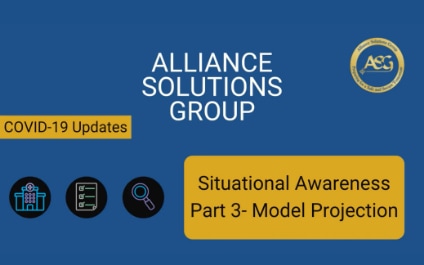This is part 3 of a series of videos from Alliance Solutions Group (ASG) regarding situational awareness during the COVID-19 global crisis. The information in this series is derived from a course called Crisis Leadership and Decision Making that ASG developed for the Federal Emergency Management Agency (FEMA). This course has been delivered to over one thousand leaders across the United States over the past three years.
Endsley’s model of situational awareness theory shows that stage 3 of situational awareness is projection. In this case, models are often used to estimate future outcomes. It is common knowledge that current models of the pandemic are imperfect predictions of the future. In this video, Bob Campbell shares some of the assumptions, limitations, pros and cons related to predictive modeling and their relationship to situational awareness and decision making.
- All models are wrong. In the context of COVID-related models, the following assumptions and limitations affect the accuracy of models:
- Many models lack validity and proven assumptions (e.g., mortality rates, transmission rates; don’t account for social distancing or increasing herd immunity).
- Some models are based on statistics from other countries with different behavioral contexts that affect transmission rate variance.
- Models are limited by insufficient data inputs.
- Data needs to be comprehensible in order to make a valid projection; some data inputs have not been put into proper context before application in the model.
- Models are meant to be compared to reality, so more accurate predictions can be made as new information updates the model parameters over time.
- Why we use models in decision making despite the limitations:
- Models can help decision makers improve decision quality based on alternative outcomes.
- Models can estimate and prioritize resource needs based on risk.
- Recalibrating the model based on reality can improve predictive outcomes.
- Considering the rate of change of modeled outcomes as the model is updated (e.g, as the rate of change slows, updated models may be considered more accurate and reliable), can provide a leading indicator.
Projections should not be used to predict the future, but rather to compare alternatives and their relative impacts, which ultimately leads to higher quality decision making.
ASG is committed to providing solutions to prepare communities for a safer, more secure tomorrow. To help leaders navigate the current crisis safely and effectively, ASG is leveraging its library of innovative products and services such as courses that have been used to train thousands of first responders, military, medical workers, and industrial workplaces on infectious disease control and prevention. To learn more about how ASG could support you during this time, visit www.asg-inc.org or call 757-223-7233.
Don't worry, no spam here!
Keep up to date with the latest trends, best practices and innovations in the Emergency Management and Environmental, Health and Safety sectors.

